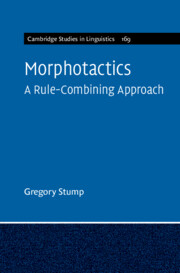Book contents
- Morphotactics
- Cambridge Studies in Linguistics
- Morphotactics
- Copyright page
- Dedication
- Contents
- Figures
- Tables
- Preface and Acknowledgments
- Abbreviations
- Symbols and Operators
- 1 Canonical Morphotactics
- 2 Rule Combinations
- 3 Dependent Rules and Carrier Rules
- 4 Rule Composition and Rule Ordering
- 5 Extending Canonical Morphotactic Criteria to Composite Rules
- 6 Rule Combinations Expressing Holistic Content
- 7 Rule Aggregation
- 8 Complex Morphotactic Interactions in Swahili
- 9 The Nonassociativity of Rule Composition in Murrinhpatha
- 10 Potentiation and Counterpotentiation
- 11 Rule Combinations and Morphological Simplicity
- 12 Rule‑combining Morphotactics and Morphological Theories
- 13 Conclusions
- References
- Index
10 - Potentiation and Counterpotentiation
Published online by Cambridge University Press: 24 November 2022
- Morphotactics
- Cambridge Studies in Linguistics
- Morphotactics
- Copyright page
- Dedication
- Contents
- Figures
- Tables
- Preface and Acknowledgments
- Abbreviations
- Symbols and Operators
- 1 Canonical Morphotactics
- 2 Rule Combinations
- 3 Dependent Rules and Carrier Rules
- 4 Rule Composition and Rule Ordering
- 5 Extending Canonical Morphotactic Criteria to Composite Rules
- 6 Rule Combinations Expressing Holistic Content
- 7 Rule Aggregation
- 8 Complex Morphotactic Interactions in Swahili
- 9 The Nonassociativity of Rule Composition in Murrinhpatha
- 10 Potentiation and Counterpotentiation
- 11 Rule Combinations and Morphological Simplicity
- 12 Rule‑combining Morphotactics and Morphological Theories
- 13 Conclusions
- References
- Index
Summary
A familiar phenomenon in derivational morphology is potentiation – the creation of new contexts for some affix by the prior addition of some other affix; thus, ‑able potentiates ‑ity in English. Less familiar is the reverse phenomenon of counterpotentiation – the licensing of an affix by the subsequent addition of some other affix. In English, -al counterpotentiates -ic in forms such as whimsical, which has no counterpart in -ic without -al (*whimsic). Facilitatory relations of these two sorts reflect distinct modes of rule combination. The potentiation of an outer rule by an inner rule is a kind of rule composition in which the domain-of-definition of the composite is that of the inner rule; the counterpotentiation of an inner rule by an outer rule is a mode of rule combination in which the domain-of-definition of the combination is disjoint from that of the inner rule. Potentiation enhances conformity to the intermediate well‑formedness criterion; counterpotentiation is a deviation from this criterion.
- Type
- Chapter
- Information
- MorphotacticsA Rule-Combining Approach, pp. 298 - 320Publisher: Cambridge University PressPrint publication year: 2022

